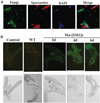Development of transgenic fungi that kill human malaria parasites in mosquitoes
- PMID: 21350178
- PMCID: PMC4153607
- DOI: 10.1126/science.1199115
Development of transgenic fungi that kill human malaria parasites in mosquitoes
Abstract
Metarhizium anisopliae infects mosquitoes through the cuticle and proliferates in the hemolymph. To allow M. anisopliae to combat malaria in mosquitoes with advanced malaria infections, we produced recombinant strains expressing molecules that target sporozoites as they travel through the hemolymph to the salivary glands. Eleven days after a Plasmodium-infected blood meal, mosquitoes were treated with M. anisopliae expressing salivary gland and midgut peptide 1 (SM1), which blocks attachment of sporozoites to salivary glands; a single-chain antibody that agglutinates sporozoites; or scorpine, which is an antimicrobial toxin. These reduced sporozoite counts by 71%, 85%, and 90%, respectively. M. anisopliae expressing scorpine and an [SM1](8):scorpine fusion protein reduced sporozoite counts by 98%, suggesting that Metarhizium-mediated inhibition of Plasmodium development could be a powerful weapon for combating malaria.
Figures



Comment in
-
Viability of GM fungi crucial to malaria control.Science. 2011 Apr 8;332(6026):175. doi: 10.1126/science.332.6026.175. Science. 2011. PMID: 21474739 No abstract available.
Similar articles
-
Plasmodium falciparum: ingested anti-sporozoite antibodies affect sporogony in Anopheles stephensi mosquitoes.Exp Parasitol. 1988 Aug;66(2):171-82. doi: 10.1016/0014-4894(88)90088-4. Exp Parasitol. 1988. PMID: 3294024
-
Plasmodium falciparum: release of circumsporozoite protein by sporozoites in the mosquito vector.Exp Parasitol. 1992 Sep;75(2):248-56. doi: 10.1016/0014-4894(92)90185-d. Exp Parasitol. 1992. PMID: 1516673
-
Sporozoite transmission by Anopheles freeborni and Anopheles gambiae experimentally infected with Plasmodium falciparum.J Am Mosq Control Assoc. 1992 Dec;8(4):404-8. J Am Mosq Control Assoc. 1992. PMID: 1474388
-
Interrupting malaria transmission by genetic manipulation of anopheline mosquitoes.J Vector Borne Dis. 2003 Sep-Dec;40(3-4):73-7. J Vector Borne Dis. 2003. PMID: 15119075 Review.
-
Malaria parasite development in mosquitoes.Annu Rev Entomol. 1998;43:519-43. doi: 10.1146/annurev.ento.43.1.519. Annu Rev Entomol. 1998. PMID: 9444756 Review.
Cited by
-
Converting endogenous genes of the malaria mosquito into simple non-autonomous gene drives for population replacement.Elife. 2021 Apr 13;10:e58791. doi: 10.7554/eLife.58791. Elife. 2021. PMID: 33845943 Free PMC article.
-
Combining transgenesis with paratransgenesis to fight malaria.Elife. 2022 Oct 25;11:e77584. doi: 10.7554/eLife.77584. Elife. 2022. PMID: 36281969 Free PMC article.
-
A fungal pathogen deploys a small silencing RNA that attenuates mosquito immunity and facilitates infection.Nat Commun. 2019 Sep 20;10(1):4298. doi: 10.1038/s41467-019-12323-1. Nat Commun. 2019. PMID: 31541102 Free PMC article.
-
Rodents as vehicle for delivery of transgenic bacteria to make paratransgenic sand fly vectors of cutaneous leishmaniasis in field condition.Sci Rep. 2023 Sep 9;13(1):14912. doi: 10.1038/s41598-023-41526-2. Sci Rep. 2023. PMID: 37689736 Free PMC article.
-
Improved efficacy of an arthropod toxin expressing fungus against insecticide-resistant malaria-vector mosquitoes.Sci Rep. 2017 Jun 13;7(1):3433. doi: 10.1038/s41598-017-03399-0. Sci Rep. 2017. PMID: 28611355 Free PMC article.
References
Publication types
MeSH terms
Substances
Grants and funding
LinkOut - more resources
Full Text Sources
Other Literature Sources

